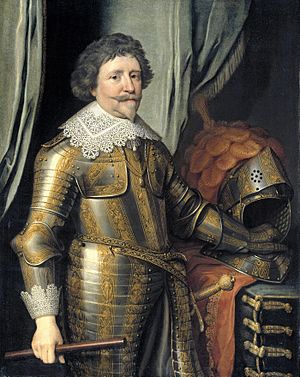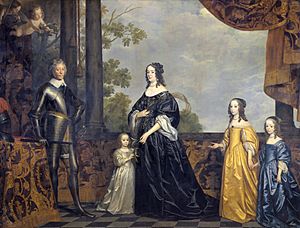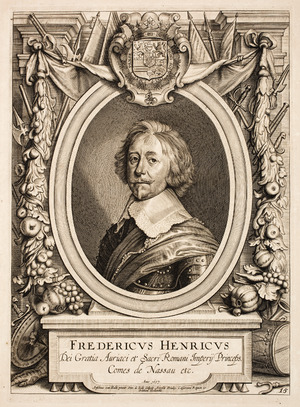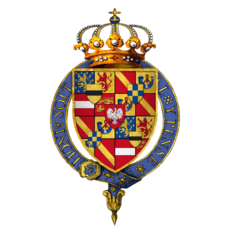Frederick Henry, Prince of Orange facts for kids
Quick facts for kids Frederick Henry |
|
|---|---|

Portrait by Michiel Janszoon van Mierevelt, 1632
|
|
| Prince of Orange | |
| Reign | 23 April 1625 - 14 March 1647 |
| Predecessor | Maurice |
| Successor | William II |
| Stadtholder of Holland, Zeeland, Utrecht, Guelders, and Overijssel | |
| Predecessor | Maurice, Prince of Orange |
| Successor | William II, Prince of Orange |
| Born | 29 January 1584 Delft, Dutch Republic |
| Died | 14 March 1647 (aged 63) The Hague, Dutch Republic |
| Spouse | Amalia of Solms-Braunfels |
| Issue | William II, Prince of Orange Louise Henriette, Duchess of Prussia Henriette Amalia of Nassau Alexandra of Nassau Isabella Charlotte of Nassau Albertine Agnes of Nassau Henriette Catherine, Princess of Anhalt-Dessau Henry Louis of Nassau Maria, Countess Palatine of Simmern-Kaiserslautern |
| House | Orange-Nassau |
| Father | William the Silent |
| Mother | Louise de Coligny |
| Religion | Dutch Reformed |
Frederick Henry (born 29 January 1584 – died 14 March 1647) was an important leader in the Dutch Republic. He was the prince of Orange and also a "stadtholder" (which was like a governor or chief executive) for several provinces. These included Holland, Zeeland, Utrecht, Guelders, and Overijssel. He held these roles from 1625 until his death in 1647. For the last seven years of his life, he was also the stadtholder of Groningen.
Frederick Henry was a skilled military leader. He played a key role in the Dutch wars against Spain. One of his greatest achievements was capturing the city of 's-Hertogenbosch in 1629. This city was a major Spanish base and very well protected. His successful military campaigns earned him the nickname 'city forcer'.
Contents
Biography
Early Life and Family
Frederick Henry was born on 29 January 1584 in Delft, a city in the Dutch Republic. He was the youngest child of William the Silent and Louise de Coligny. His father, William, was a famous leader and stadtholder of several Dutch provinces. His mother, Louise, was the daughter of a French Protestant leader.
Frederick Henry was born just six months before his father was assassinated. His older half-brother, Maurice, who was a brilliant general, trained him in military skills. In 1625, Frederick Henry married his cousin, Amalia of Solms-Braunfels. Before his marriage, he had a son named Frederick Nassau de Zuylestein. This son later helped to raise the young William III of England.
Becoming a Leader
When his brother Maurice died in 1625, Frederick Henry took over his important roles. He became the Prince of Orange and the stadtholder of five provinces: Holland, Zeeland, Utrecht, Overijssel, and Guelders. He also became the commander-in-chief of the Dutch army and navy.
Frederick Henry proved to be a very good general, almost as skilled as his brother. He was also a much better politician and statesman. For 22 years, he led the government of the United Provinces. During his time, the power of the stadtholder reached its peak. This period is often called the "golden age" of the Dutch Republic. It was a time of great military victories, worldwide trade, and amazing achievements in art and literature.
Military Victories and Peace
Frederick Henry's main military successes included capturing several important cities. He took Grol in 1627, 's-Hertogenbosch in 1629, and Maastricht in 1632. He also captured Breda in 1637, Sas van Gent in 1644, and Hulst in 1645.
For most of his time as leader, Frederick Henry worked with France against Spain. However, towards the end of his life, he decided to make a separate peace with Spain. This peace treaty gave the United Provinces all the benefits they had been fighting for over eighty years.
Frederick Henry also built beautiful country houses. These included Huis Honselaarsdijk and Huis ter Nieuwburg. He also built Huis ten Bosch for his wife and renovated the Noordeinde Palace in The Hague. Sadly, Huis Honselaarsdijk and Huis ter Nieuwburg are no longer standing.
Death and Legacy
Frederick Henry died on 14 March 1647 in The Hague. He was buried with great ceremony next to his father and brother in Delft. The treaty of Munster, which officially ended the long war between the Dutch and the Spanish, was signed shortly after his death. His illness and death had caused a delay in the negotiations.
His wife, Amalia, ordered a special monument to be built for him. It was placed in a grand room called the Oranjezaal. This room was decorated with paintings showing scenes from his life and celebrating his achievements.
Children

Frederick Henry and his wife, Amalia of Solms-Braunfels, had nine children. They had seven daughters and two sons. Sadly, four of their children, including one son, died when they were very young. This left Frederick Henry with only one son to inherit his titles.
His children were:
- William II, Prince of Orange (1626–1650)
- Luise Henriette of Nassau (1627–1667)
- Henriëtte Amalia of Nassau (1628)
- Elisabeth of Nassau (1630)
- Isabella Charlotte of Nassau (1632–1642)
- Albertine Agnes of Nassau (1634–1696)
- Henriette Catherine of Nassau (1637–1708)
- Hendrik Lodewijk of Nassau (1639)
- Maria of Nassau (1642–1688)
Frederick Henry also had one illegitimate son, Frederick Nassau de Zuylestein (1624–1672).
Titles and Coat of Arms
Frederick Henry held many important titles during his life. He was the Stadtholder of several provinces, which was an appointed role. He was also the hereditary sovereign of the principality of Orange, a territory in what is now France.
He also had many other noble titles, which showed his wealth and power. These included:
- Marquis of Veere and Vlissingen
- Count of Nassau-Dillenburg, Buren, Leerdam, Katzenelnbogen, and Vianden
- Viscount of Antwerp
- Baron of Breda, Diest, Grimbergen, and many other places.
|
See also
 In Spanish: Federico Enrique de Orange-Nassau para niños
In Spanish: Federico Enrique de Orange-Nassau para niños




